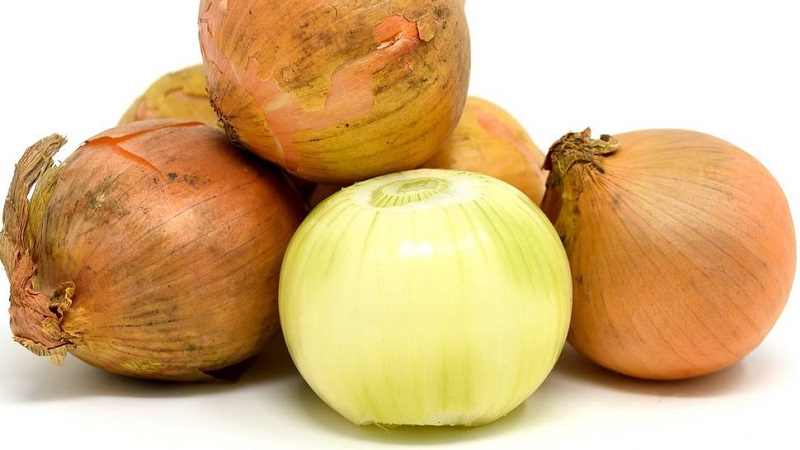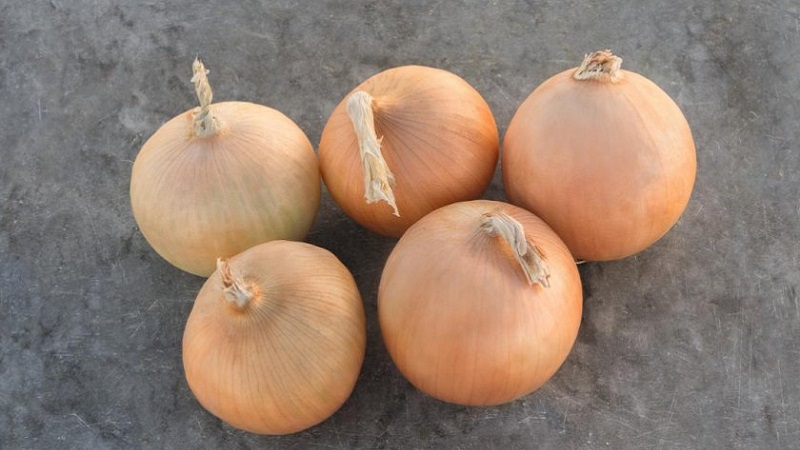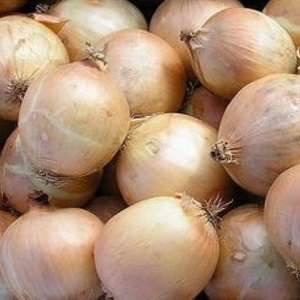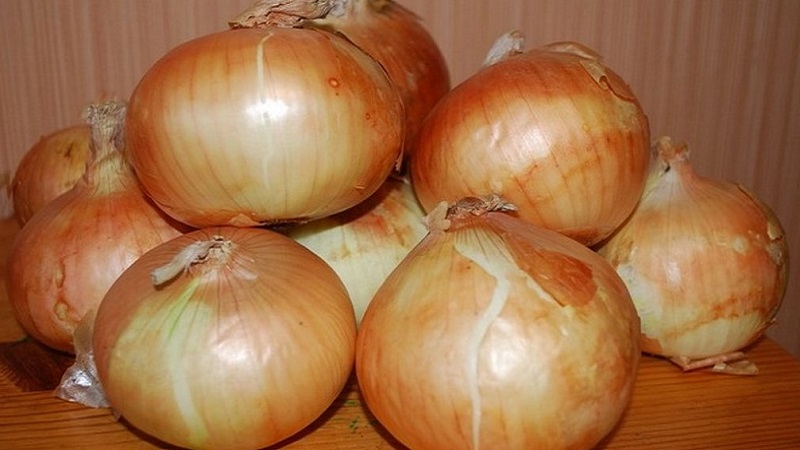Cold-resistant onion variety Radar for planting before winter
Onions are grown in all regions of the country, both in vegetable farms and in private plots. For winter farming, frost-resistant onion varieties are chosen for planting, for example, Radar from Dutch breeders. It is unpretentious in growing and resistant to adverse conditions, rich in useful compounds.
In the article you will find a short description of the variety, the nuances of planting and care, you will learn how and when to plant the Radar winter onion before winter.
The content of the article
Description of the Radar variety
The Radar variety is a winter, cold-resistant, mid-season onion, not prone to shooting.
Cold-resistant onion variety The radar was obtained as a result of the labors of Dutch breeders about 30 years ago.

Application features
It is important to eat onions in winter and spring, when the body is deficient in vitamins. His universal use in cooking: eaten raw, boiled, fried, stew, bake.
Delicate taste with moderately spicy notes will suit dishes made from vegetables, meat and will complement soups, borscht, stews. This vegetable is ideal as a seasoning for meat and fish.
For more information about this variety, read in our other article.
Ripening period and yield
Radar is an early ripening variety characterized by frost resistance... The first crop is harvested 250-270 days after planting. The first greens are cut in mid-May, and large bulbs are dug up at the end of June.
The Radar variety is considered a high-yielding variety, because from a small set, an onion weighing from 90 to 150 g, and sometimes up to 300 g, is obtained at the output.

Disease resistance
There is a high resistance of the variety to shooting, pests and diseases... It is important to observe crop rotation - not to plant onions on one bed for more than 2 years in a row, to alternate crops correctly, and also to carry out preventive spraying.
Bulb characteristics
The head is dense, transversely elliptical, juicy inner scales of white... The outer husk is dry, dense, golden in color. Feathers are glossy, dark green. Medium onion neck. The taste is semi-sharp.
Which regions are best suited for
Initially, the Radar onion variety was intended for planting in the North Caucasus region... However, due to its undemanding climatic conditions and soil quality, it is successfully cultivated in all regions of the country. Only the timing of planting differs depending on the region of growth.
Radar transfers temperature -13… -16 ° C in a winter with little snow, and under a thick cover of snow it hibernates at a temperature of -25 ° C.
The main advantages and disadvantages of the variety
Advantages:
 high germination of seedlings;
high germination of seedlings;- unpretentiousness to soil quality and weather conditions;
- good productivity;
- keeping quality;
- disease and shooting resistance;
- strong root system and thin onion neck.
There are no significant flaws in the variety.
Unlike popular varieties of onions planted in spring, the cost of Radar is significantly lower.And from other winter varieties, for example, Karatalsky or Boterus, Radar is distinguished by good keeping quality and resistance to diseases. Although its yield is somewhat lower.
Features of planting and growing
When planting a Radar onion before winter, the deadlines are observed planting, digging the beds and preparing planting material.
Preparing for landing
High-quality planting material is selected - sets up to 1 cm long, without signs of spoilage, rot and germination. Then it is dried in a warm place for 2-3 weeks. This is followed by two-fold processing of winter seedlings. First, it is placed for 5 minutes in a 3% sodium chloride solution, and then disinfected in a strong solution of potassium permanganate for half an hour. Dry the seedlings before planting.
Reference! Experienced gardeners practice planting a sevka cut in half. Both halves will be accepted if they have roots.
Ground requirements
Variety Radar is not picky about soil composition... The beds are made where water does not stagnate in spring, after the snow melts. A well-lit place is chosen. The preparation of the beds begins about 1.5 months before planting.
The soil is cleaned of plant debris, dug up and spilled with a disinfecting compound, for example, a solution of potassium permanganate. After that, fertilizers are applied: humus or rotted compost, potassium salt, superphosphate.
Important! It is not recommended to fertilize the soil with fresh manure. From this, the green mass will grow, and the bulb will become loose. Such a bow will become unsuitable for long-term storage.
Predecessors
It is best to plant winter onions where previously tomatoes, garlic, cucumbers grew... Do not plant it in place carrots, cabbage and any other onions.
Timing, scheme and landing rules
The timing of planting winter onions depends on the climatic conditions of the region.... For example, in the Northwest part of the country Radar plant in early October, in the Moscow region - in mid-October, in the Krasnodar Territory or in the Stavropol Territory - in early November.

Landing scheme:
- Prepare beds more than 30 cm apart. Level and compact the soil.
- Make grooves 5 cm deep.
- Place the sevok in the groove at a distance of 10 cm from each other.
- Cover with peat-humus mixture.
- Mulch the soil with straw, and cover it with spruce branches on top to retain snow.
Geotextile is considered the best mulch material.... It is a special white non-woven fabric that permits moisture and air to the soil well and restrains weeds.
Growing features
After planting the onion Radar in the fall, watering is not required... In winter, they additionally throw snow on the garden bed. Mulch is harvested in spring to warm the soil.
The nuances of care
For a good harvest, provide the vegetable with minimal care, consisting in watering the beds, loosening the soil and timely fertilizing.
Watering mode
Start glaze falls in the middle or end of May... 1-2 times a week, the bed is spilled with settled water at room temperature. 6-8 liters of water are consumed per 1 m². The frequency of watering depends on the amount of rainfall.
Loosening the soil and weeding
After each watering, the soil is allowed to dry and the top layer is loosened... This is done carefully, without going deep, so as not to damage the bulb. At the same time, weeds that hinder full growth are removed.
Top dressing
The first feeding with ash is carried out immediately after the snow melts... 1 tbsp. l. ash is diluted in 10 liters of water. The next feeding is done when 4 green feathers are formed on the onion - organic fertilizers are used, for example, a solution of bird droppings. It is diluted in water in a ratio of 1:15, insisted for at least 5 days.
The next time feeding is done after 14 days. superphosphate, urea and potassium. Use 2 liters of liquid fertilizer per 1 m².
Disease and pest control
Bow Radar prone to peronosporosis - downy mildew... The reasons are weakened plant immunity and waterlogging of the soil. Affected plants are sprayed with the preparation "HOM" 2-3 times with a break of 10 days.In order to prevent, plants that have reached 10 cm are irrigated with Bordeaux liquid, and the beds are powdered with tobacco dust.
The most dangerous defeat for the Radar variety onion flies... For the prevention and control of insects, plantings are sprayed with a solution of 150 g of salt and 10 liters of water and the plants are promptly powdered with tobacco dust and wood ash alternately. If for a long time it is not possible to get rid of the flies, then bioinsecticides "Aktara" or "Alatar" are used - 50 ml per 10 liters of water.
Important! To get a more lasting result, add a little liquid soap to the onion fly solution.
Harvesting and storage
Vegetation period - 250-270 days... A vegetable is considered ripe when the feather turns yellow and "lies" on the ground, and the bulb is overgrown with golden husks. Quite often the feather does not “lie down”, but by all indications the onion is ripe. In this case, it is laid by hand.

Collection and storage rules:
- Cleaning carried out in dry weather. It is manually pulled out of the ground, undermining with a pitchfork.
- The collected bulbs are sorted by size, leaving small ones for winter planting, and large ones for storage.
- Dry in a place protected from precipitation for 10 days or until the root collar is dry.
- After that, dry feathers and roots are trimmed, and the onions are sent to a cool place, for example, a cellar. You don't need to trim the feathers, but weave a braid from such a bow. So it will be well preserved, as in a box or nylon stocking.
The variety has good keeping quality.
What can be the difficulties in growing
Gardeners do not notice any particular difficulties in the cultivation of onions, but sometimes the following problems occur:
- Germination of onions ahead of schedule. Plant winter onions no earlier than October.
- Rotting bulbs. The reason is excessive watering or the wrong place for a garden bed in a lowland.
- Onions will not germinate if, when planting, the seedlings are buried more than 10 cm.
- Buying a low-quality set. Purchase seed from trusted sellers. The packaging should be made of mesh and contain information about the timing and conditions of planting.
Tips from experienced gardeners
Recommendations from farmers who have grown this variety for a long time:
- Sevok is kept in a warm room for at least 2 months to avoid shooting.
- Pour a mixture of sand and ash into the groove, and plant onions on top.
- Use only organic matter as mulch - corn leaves, tops, hay. You cannot cover the bed with plastic wrap.
- Check with the lunar calendar. In the full moon phase, the bow is not planted.
Reviews of the onion variety Radar
Gardeners speak positively about the Radar onion variety.
Alena Ivanovna, Rzhev: “I love planting onions before winter - a minimum of hassle, and fresh vegetables at the beginning of summer. I really like the Radar variety for its ease of cultivation, good storage in winter and moderately spicy taste. The husband asks to marinate the barbecue with him! ".
Constantine, Armavir: “In the south, we usually plant winter onions in early November. At this time we have warmth and there is time before frost. If the winter is snowy, then the onions will be large and sweet. Radar began to grow recently, and now it is my favorite ".
Borovoy Sergey, Stavropol Territory: “A neighbor once shared a jar of Radar onion sets. Why haven't I heard of him before? No hassle with planting in the winter. In May, there are already strong, juicy greens on the feather. In July - large heads of bitter onions. Now I advise everyone to put Radar on ".
Conclusion
The Radar variety is characterized by high productivity and medium early ripening. It is undemanding to the composition and quality of the soil, suitable for cultivation in all regions of the country.
Cultivation of winter onions Radar is within the power of even a beginner. By following simple agronomic techniques, you will get a high-quality harvest of mid-season onions, which are also perfectly stored.